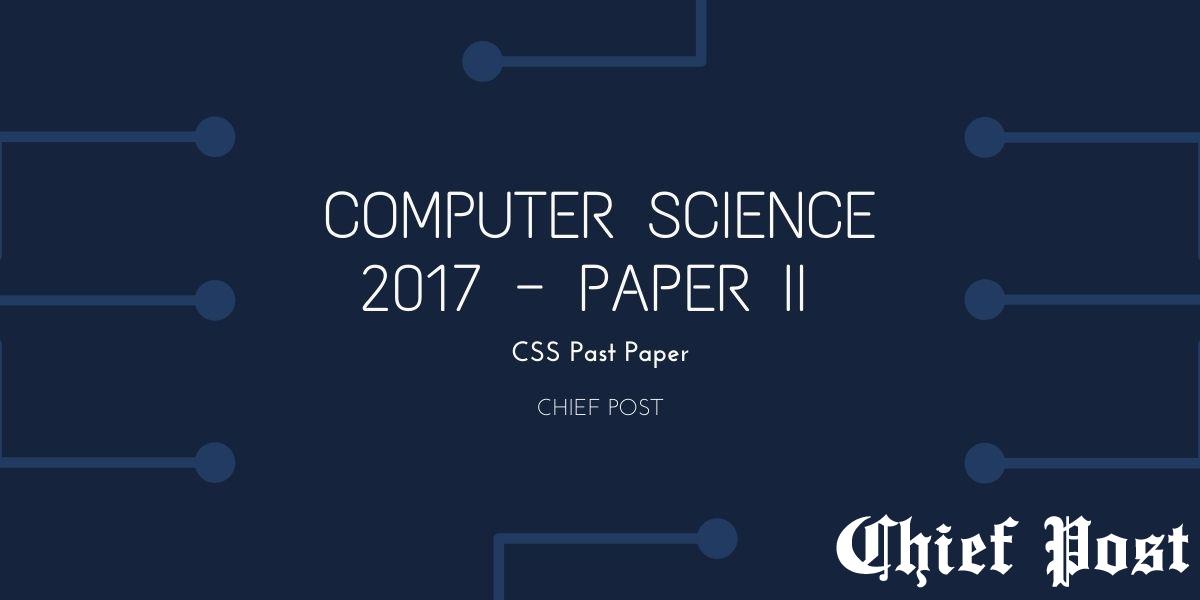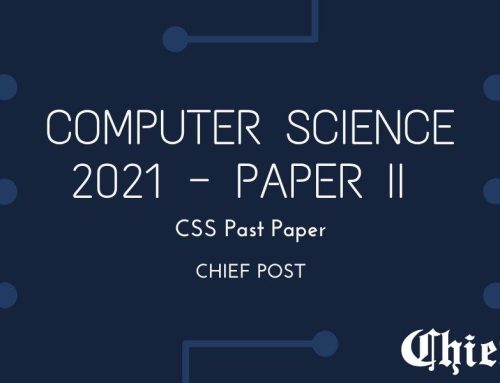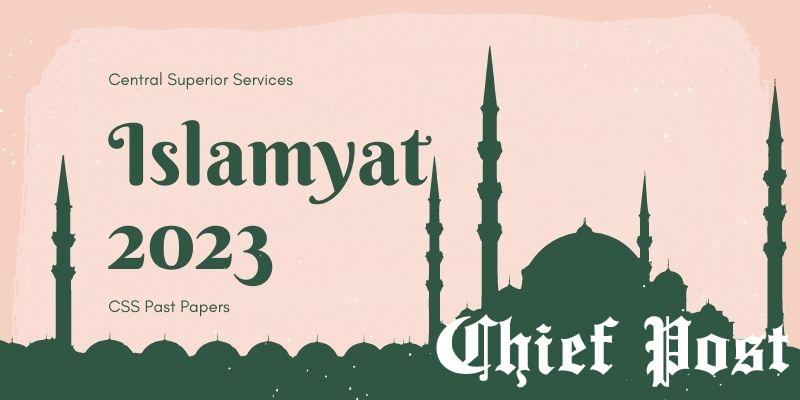
Computer Science 2017, Paper 2 — CSS Past Paper
NOTE: Other Paper is published separately.
NOTE: You can download this paper, the links are given at the end of the page.
FEDERAL PUBLIC SERVICE COMMISSION
COMPETITIVE EXAMINATION-2017 FOR RECRUITMENT TO POSTS IN BS-17 UNDER THE FEDERAL GOVERNMENT
COMPUTER SCIENCE, PAPER-II
TIME ALLOWED: THREE HOURS PART-I(MCQS): MAXIMUM 30 MINUTES PART-I (MCQS) MAXIMUM MARKS = 20 PART-II MAXIMUM MARKS = 80 NOTE:
- (i) Part-II is to be attempted on the separate Answer Book.
- (ii) Attempt ONLY FOUR questions from PART-II by selecting TWO questions from EACH SECTION.
- (iii) All the parts (if any) of each Question must be attempted at one place instead of at different places.
- (iv) Candidate must write Q. No. in the Answer Book in accordance with Q. No. in the Q.Paper.
- (v) No Page/Space be left blank between the answers. All the blank pages of Answer Book must be crossed.
- (vi) Extra attempt of any question or any part of the attempted question will not be considered.
PART-II SECTION-A
Q. 2. (a) Discuss the following methods of storage systems: (i) Direct Access (ii) Random Access (b) If clock speed reaches its maximum then what are the two methods to increase the performance of a computer? Briefly explain. (c) Draw and explain instruction execution state diagram with interrupt. (8) (6) (6) Q. 3. (a) Explain the following network protocols: (i) HTTP and SIP (ii) TCP and UDP (b) What is the transmission time of a packet sent by a station if the length of the packet is 1 million bytes and the bandwidth of the channel is 200 Kbps? (c) Given the IP address 10.5.118.3 and the network mask 255.255.240.0, what are the assignable IP addresses and broadcast in this subnet? (8) (6) (6) Q. 4. (a) What are differences between Optimal & LRU (Least Recently Used) page Replacement Policies? (b) Discuss the four necessary conditions for deadlock to occur. How can we deny any two of these conditions? (c) Consider three processes given in the table. Find average waiting time and average turnaround (completion) time when these processes are scheduled using Round-Robin scheduling using time quantum (TQ) = 4.

Computer Science 2017, Paper two, diagram 1
(8) (6) (6) Q. 5. (a) Explain the functionality and purposes of following registers with diagrams: (i) Memory Address Register (MAR) (ii) Memory Buffer Register (MBR) (iii) Instruction Register (IR) (b) Discuss the functionality of Ethernet LAN and its types. (c) What happens in the following cases? (i) If the job size is kept very low in time sharing systems. (ii) If the page size is kept very small in paged memory management. (8) (6) (6)
SECTION-B
Q. 6. (a) What is Normalization? Discuss 1NF, 2NF and 3NF with example(s). (b) Write short notes on the following: (i) Data (ii) Database (iii) Database Management System (c) Differentiate between Centralized Database and Distributed Database. (8) (6) (6) Q. 7. (a) Define image histogram. What is meant by histogram equalization? Explain their applications in image processing. (b) Find the storage in bytes required to store a 256 x 200 colored image using RGB color model with 24 bit color depth. (c) Briefly explain Geometric Transformations. (8) (6) (6) Q. 8. (a) Explain the following web concepts: (i) localStorage and sessionStorage objects (ii) Application cache in HTML5 (iii) Manifest file (iv) Web Worker (b) What is SVG? What are the advantages of SVG over JPEG or GIF? (c) Explain Non Breaking space in HTML with example. (8) (6) (6)
**********
You can Download this Paper from Google Drive or Dropbox.
Download from Google Drive: Click Here
Download from Dropbox: Click Here










